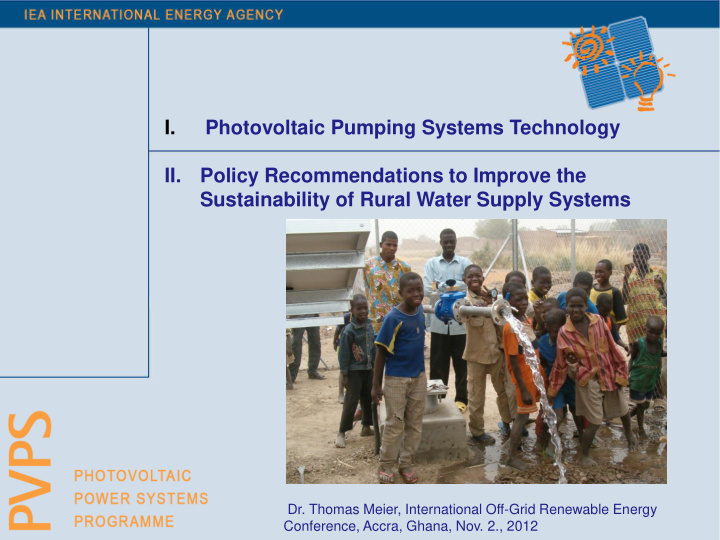



I. Photovoltaic Pumping Systems Technology Task 9 Position Paper II. Policy Recommendations to Improve the Sustainability of Rural Water Supply Systems Policy Recommendations to Improve the Sustainability of Rural Water Supply Systems Based on the Experience with Conventional and Photovoltaic Pumping Systems by Thomas Meier, IEA-PVPS Task 9 Expert Meeting Copenhagen, Feb. 10, 2011 Dr. Thomas Meier, International Off-Grid Renewable Energy Conference, Accra, Ghana, Nov. 2., 2012
Contents 1. The Link between Water, Energy and Sustainable Development 2. Examples of Solar Powered Water Supplies in Off-grid Areas 3. Solar Pumping Technologies 4. Experiences with Conventional Rural Water Supply Systems 5. Economics of Solar Pumping vs. Fossil Fuel Powered Systems 6. Lessons Learned and Policy Recommendations
The Link between Water, Energy and Sustainable Development - 7% of total world energy consumption is consumed for the provision water services. - MDG target: to halve, by 2015, the proportion of the population without sustainable access to safe drinking water and basic sanitation. - About 2.8 billion people suffer from water scarcity, est. 50% of them in off-grid areas. Renewable energy powered water services contribute to sustainable development in off-grid areas of developing countries through increased energy independence and thus reducing the vulnerability of their economies and people.
The Link between Water, Energy and Sustainable Development Competing Water Uses Source: Unesco, 2003
Examples of Solar Powered Water Supplies in Off-grid Areas Application Range: - Handpumps are least cost option up to 25m4 per hour, - Motorized pumps are needed for higher pumping energies - PVP is mainly competing with Diesel pumping systems Economic Viability of PV Pumping depends on local costs for diesel fuel and price developments of PV components
Examples of Solar Powered Water Supplies in Off-grid Areas Source: Mono Pumps, 2012
Examples of Solar Powered Water Supplies in Off-grid Areas Photos: Wirzsolar, 2011
Examples of Solar Powered Water Supplies in Off-grid Areas Photos: Erla Hlín Hjálmarsdóttir, 2011
Examples of Solar Powered Water Supplies in Off-grid Areas Water Purification System -Ultrafiltration (removes 99.9% of bacteria and viruses) -1200l/h -Power supply 720Wp -Power consumption 100-350W Source: Trunz Water Systems, 2011
4. Solar Pumping Technologies Helical Rotor Pump Centrifugal Pump (progressive cavity pump) -medium to high heads (up to 350m) -low to medium heads (up to 170m) -low flows (2.5 to 4 m3/hour) -high flows (10 to 70 m3/h) Sources: Wikipedia and Grundfos
4. a) Experiences with Conventional Rural Water Supply Systems Main concept pursued: VLOM (Micro-level approach) -Supply of handpumps for small communities, -Improvement of wells operated by individual households (self supply), Project characteristics: -Heavily subsidized donor driven projects, -Little consideration of national policies, -Low water usage fees, -Too little consideration of maintenance for long term operation.
4. a) Experiences with Conventional Rural Water Supply Systems Results achieved: -Hundreds of thousands handpumps installed, -Numerical targets achieved, Problems encountered: -up to 50% of handpumps out of operation due to -non-affordability or non-availability of spare parts, -communal management problems, -overpricing of system components due to market distortion effects. more than 1 billion people remain without sustainable water supply
Photo: RWSN
5. Economics of Solar Pumping vs. Fossil Fuel Powered Systems Development of Prices for PV Modules, Roof-top Systems and Diesel Fuel 11.00 US Diesel Prices [US$/l] 10.00 PV Module Prices [US$/Wp] 9.00 German PV Systems [EUR/Wp] 8.00 7.00 6.00 5.00 4.00 3.00 2.00 1.00 0.00 1994 1995 1996 1997 1998 1999 2000 2001 2002 2003 2004 2005 2006 2007 2008 2009 2010 2011
Comparison of Life Cycle Cost of a PV vs Diesel System
Comparison of Life Cycle Cost of a PV vs Diesel System Solar Pumping Diesel Pumping
Unit Water Cost
Known Problems of PV Pumping -PVP is a mature technology with very low failure rates. Mean time to failure rate of PV components is almost 9 years. -Water distribution component are more prone to failure and can lead to the collapse of whole systems (MTTF 2.3 years). PV Module Theft Water Tank PV Panels 5% Inverter 3% Dry Well 5% Pipe Failures PV Panels 21% Well Output Water Tank Leakages Leakages 16% 1% 7% 18% 3% Pump Failures Fences 8% Purification 1% System Pump Broken Water Frequency Converter Water 12% Failures Taps 7% Distribution 27% 30% Network 36% Thailand Morocco Evaluation of 500 PVP Units 49 PV units within 200km evaluated 40% out of operation after 6 yrs due after 12 years, 100% still operational, to inadequate post project support maintenance system available
6. Recommendations Increase Support to Governments in Creating Enabling Environments for Rural Water Supply Development RWS projects need to be embedded in government policies Role of donors: support the creation of enabling environments ( includes licensing, concessions, permits, pricing mechanism, capacity building, incentives, financing schemes, quality assurance, technology advice etc.) Attract Private Investors to Leverage Available Funds Where an enabling environment allows private investors to achieve adequate returns up to 70% of required investment can be raised from the private sector.
6. Recommendations Develop Rural Water Supply Projects at Scale Sustainable operation requires maintenance service providers. This requires a critical number of pumping systems in a region making repair services economically feasible. To operate on a financially sustainable basis, a maintenance service provider should be able to achieve an annual turnover of the order of USD 50,000 to USD 60,000. Base Investment Decisions on Life-Cycle Cost of Rural Water Supply Infrastructure Investment Decisions taken on the grounds of initial investment costs result in too high operational costs for rural communities. Sustainable operation requires low life-cycle costs.
6. Recommendations Consider the whole Water Chain to Guarantee System Reliability PVP technology has very low failure rates. Where PV contractors are not in charge for the whole water chain, system break downs are often related to leaking tanks, pipes, or broken taps.
Contacts Thomas Meier – tmeier@bluewin.ch
Recommend
More recommend